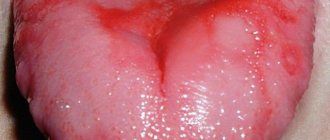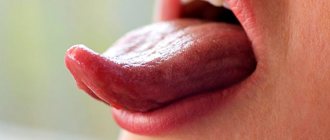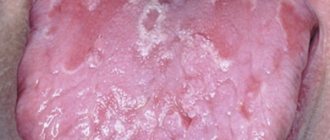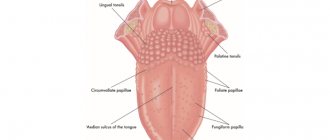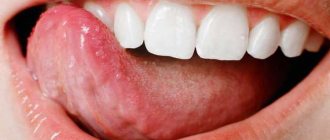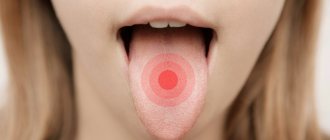The tongue is quite often injured. Sometimes these damages are so minimal that we pay due attention to them; however, minor defects in the mucosa are entry points for infection. Glossitis is an inflammation of the tongue caused by various bacteria and viruses. The disease is accompanied by a number of unpleasant symptoms that interfere with normal food intake, and sometimes even interfere with talking. If measures are not taken in time, diffuse purulent inflammation may occur, spreading far beyond the oral cavity. Most often, glossitis occurs in people with reduced immunity, smokers and people who are negligent about oral hygiene.
Symptoms of glossitis
The first thing those suffering from glossitis encounter is pain, burning, and severe discomfort in the oral cavity. Over time, the intensity of these manifestations increases, making it difficult to eat food. Taste sensations are dulled and may be completely absent. Some patients develop a perverted taste. The tongue begins to swell, which causes severe discomfort. The patient's speech is impaired, any movements of the tongue bring pain. Hyperthermia and deterioration in general health are possible. Upon examination, you can reveal an enlargement of the tongue, a change in its color to a brighter one, up to crimson. Ulcers, blisters, spots, erosions, plaque, and lesions with altered epithelial structure may appear on the mucous membrane.
The most dangerous complication of glossitis is phlegmon. A focus of purulent inflammation is formed, which rapidly spreads to the chin and neck and destruction of soft tissues. Such patients require emergency medical care.
Types of glossitis
Taking into account the main symptoms, glossitis is divided into the following types:
- Geographical. This type of pathology is more common in females and begins with the appearance of a light spot on the tongue with a diameter of several millimeters. Gradually, the affected area can gradually increase. Over time, the shade of the spot changes to pink and begins to stand out strongly against the background of surrounding tissues. If medical care is not provided in a timely manner, the affected area can expand to cover the entire volume of the tongue and cause a lot of problems for the patient.
- Candida. The most dangerous type of glossitis. It is caused by fungi of the genus Candida. They are always present on a person’s tongue, but do not manifest themselves; however, with the slightest weakening of the immune system, candidal inflammation of the tongue appears. Symptoms of the disease include swelling of the organ and the appearance of a brown coating on its surface. The patient suffers from a burning sensation, impaired diction, excessive salivation, and an unpleasant odor from the mouth.
- Folded glossitis. This is a congenital pathology of the tongue, leading to the formation of deep folds on its surface, which have a transverse direction. It is noteworthy that folded glossitis does not cause discomfort to a person.
- Diamond-shaped. This type of disease is characterized by the appearance of a diamond-shaped area of inflamed mucous membrane on the upper surface of the tongue, closer to the root. Doctors consider this pathology as chronic. There are no complaints from patients. Diamond-shaped glossitis can be smooth or lumpy. Most often, this disease is detected in adults.
- Gunter's glossitis. The main cause is hypovitaminosis. The main symptoms of the pathology are: atrophy of the papillae of the tongue and significant redness.
- Catarrhal. The initial stage of the inflammatory process. Most often it develops due to insufficient oral care. It can also appear if the patient has fillings or dentures made of low-quality materials in the mouth. Sometimes this type of tongue pathology appears during teething in children. The disease is always accompanied by characteristic discomfort and slight swelling of the organ.
- Atrophic glossitis. The cause is an infection that causes the death of the muscle of the organ and the papillae of the tongue. As a result, it becomes thinner. It is very difficult for patients with such glossitis to eat normally.
- Villous. Pathological increase in the size of the organ papillae. They become like villi. Villous glossitis most often appears as a result of injury to the tongue or due to bad habits.
- Ulcerative. The appearance of numerous ulcers and areas of tissue erosion on the surface of the organ. Patients complain of pain and bleeding. Often the surface of the tongue becomes yellow. There is always a putrid smell coming from the mouth. Since the tongue swells, patients have problems with diction.
- Mycotic . Caused by a fungal infection. As a rule, it develops as a complication of tonsillitis or pharyngitis. The main symptoms of the pathology are swelling of the tongue and pain. Also, characteristic spots may appear on its surface.
- Herpetic glossitis . A type of pathology provoked by the herpes virus. The main symptom of the disease is the appearance on the surface of the tongue of a large number of small bubbles containing sulfur. With herpetic glossitis, the patient complains of pain in the mouth when eating. This pathology is very contagious.
- Hypertrophic. This type of glossitis occurs when there is a lack of vitamins in the body such as: B 2, B 6 and PP. The main feature of this pathology is the appearance of gray and yellow plaque on the sides of the tongue, on which the teeth are clearly imprinted. The organ itself swells significantly.
- Allergic glossitis. This type of disease occurs due to allergic reactions. The pathology is manifested by a burning sensation, swelling of the organ and redness of the mucous membranes.
- Interstitial glossitis. This organ damage occurs with syphilis. The tongue becomes very dense, making it difficult for them to move. As a result, it is very difficult for a person to express himself. If you do not resort to treatment, the tongue may remain in this position forever.
- Viral. This pathology is characterized by the appearance of ulcers and areas of erosion on the surface of the organ. The latter look like gray or brown spots. Effective treatment of this type of pathology is possible only with the use of antiviral drugs.
It is very difficult to independently diagnose one or another glossitis, since their symptoms are largely similar. This is especially true for the initial symptoms. Therefore, when the first signs of the disease appear, you should consult a dentist.
Forms
Types of glossitis:
- deep;
- desquamative;
- diamond-shaped;
- villous;
- folded;
- Gunter's;
- syphilitic or interstitial.
The most dangerous is deep glossitis. The pathological process begins on the lower part of the tongue, and if left untreated, spreads to the floor of the oral cavity. In the case of abscess formation, the purulent process can spread to the neck, which is a life-threatening condition.
Desquamative glossitis is better known as “geographic tongue.” Irregularly shaped areas of peeling alternate with normal ones, so the tongue looks like a geographical map. This type of disease is typical for patients with chronic lesions of the digestive system, allergies, helminthic infestations, and can also occur during pregnancy.
Diamond-shaped lesions are typical for patients with chronic gastropathology. The disease is recurrent.
Villous glossitis occurs due to hypertrophy of the papillae of the tongue. This disease is one of the manifestations of a fungal infection - candidiasis, and can also occur in smokers.
The disease may be congenital. Such anomalies include a folded shape. This glossitis does not cause unpleasant symptoms and does not require special treatment.
Gunter's tongue is not an independent pathology, but one of the manifestations caused by anemia resulting from a lack of vitamin B 12 and folic acid in the body. The disease develops gradually. The mucous membrane of the tongue becomes smooth, the papillae decrease in size, and the tongue acquires a crimson hue.
Interstitial glossitis is also a secondary manifestation and is characteristic of patients with syphilis. The pathological process proceeds deeply, affecting muscle tissue. If left untreated, the muscles are replaced by connective tissue, which is an irreversible process. This form can transform into a malignant tumor.
Having seen photos of glossitis of different etiologies, you can be convinced that the clinical symptoms of this disease are varied, so only a specialist can make a differential diagnosis.
Glossitis of the tongue can be either an independent disease or one of the clinical symptoms of another pathology. For proper treatment, it is necessary to find out whether the disease is a primary inflammatory process, or arose as a result of changes in other organs and systems.
Causes of glossitis
All forms of glossitis have common properties. Any glossitis can occur due to a viral or bacterial infection. Glossitis often occurs due to mechanical trauma to the tongue, chemical and thermal damage. Glossitis may also indicate the presence of a concomitant disease or allergy in the patient’s body. Glossitis can also develop against the background of another oral disease.
The following are the most common causes of glossitis:
- damage to the tongue from sharp pieces of food or dentures;
- negative effects of hot water and food, thermal burns;
- insufficient oral care;
- smoking, alcohol abuse, poisoning with heavy metal salts;
- allergic reaction to toothpaste, mouthwash elements, orthopedic materials;
- the presence of herpes viruses, staphylococci, and yeast-like fungi in the body.
Glossitis can be a symptom of a general disease in the body. The most common cases of glossitis as a symptom of a concomitant disease are observed in the following diseases:
- infectious diseases (scarlet fever, measles and others);
- diseases of the gastrointestinal tract;
- blood diseases;
- hypervitaminosis;
- diseases of the oral cavity (especially stomatitis).
Also, different forms of glossitis can manifest themselves differently in different conditions of the body.
How is tongue inflammation treated?
The nature of treatment largely depends on the form and type of pathology. Therefore, diagnosing the disease is important when prescribing effective treatment.
In some cases, it is useless to treat glossitis itself until the root cause of the pathology is eliminated - one of the diseases of the internal organs.
Treatment of glossitis has the following general principles:
- A doctor prescribes a procedure to improve the health of the entire oral cavity.
- Using various antiseptics to rinse the mouth, for example, Miramistin, Chlorhexidine, Furacilin. If the disease manifests itself in a child, then the drug Nystatin can be used for treatment.
- When erosive areas and ulcers appear on the surface of the tongue due to glossitis, the patient is prescribed ointments with a healing effect: Kamistad, Malavit, Vinizol.
- After removing the main symptoms of the pathology, treatment of glossitis is usually completed by treating problem areas with various oils of plant origin.
- The last stage is to carry out activities aimed at increasing general and local immunity.
The methods of treatment of tongue diseases listed above are advisory in nature for all. However, they will be quite effective in most cases.
Please note that folded glossitis does not require treatment.
Symptoms
Depending on the type of disease (and there are quite a few of them), typical signs will vary. Nevertheless, there are general symptoms that are similar for all forms.
First of all, glossitis changes the appearance of the tongue: growths that are dense to the touch are formed on it or areas are formed whose color differs from the healthy mucous membrane (the shade can vary from red to burgundy). In addition to visual changes, there are other symptoms:
- burning of the tongue, often accompanied by swelling;
- increased salivation;
- feeling of a foreign body in the mouth;
- changes in taste sensations (foods may acquire an unusual taste, sometimes a person becomes completely unable to perceive the taste of food);
- difficulty swallowing;
- change in diction (speech becomes slurred; in order to express a simple thought, a person has to make serious efforts, because due to pain it is difficult for the patient to pronounce words clearly).
If treatment is neglected, there is a high probability that the disease will enter the chronic stage: its onset is indicated by a change in the structure of the tongue and a noticeable increase in its size.
Preventive techniques for glossitis
Most often, the disease is much easier to prevent than to treat.
For this reason, dentists advise following the following preventive techniques:
- following the rules of dental and oral hygiene;
- systematic preventive examination in the dental office;
- reducing the use of hot spices that irritate the mucous membrane of the tongue;
- giving up cigarettes and alcoholic beverages.
Timely and high-quality treatment can easily eliminate glossitis, while the complete absence of therapy leads to irreversible and sad consequences.
Answers on questions
What diagnostics are carried out before treatment?
The dentist examines the patient, collects medical history data: complaints, data on the patient’s general health (presence of chronic diseases). If necessary, laboratory diagnostics are prescribed: a smear (culture) from the oral cavity for microflora.
How to treat hairy tongue in adults?
The doctor prescribes complete sanitation of the oral cavity: removal of stone, plaque, and carious teeth. Selects individual home hygiene products. Prescribes a diet that includes plenty of fluids and solid vegetables. Smoking is prohibited. If necessary, the dentist prescribes rinsing solutions and antibacterial agents.

